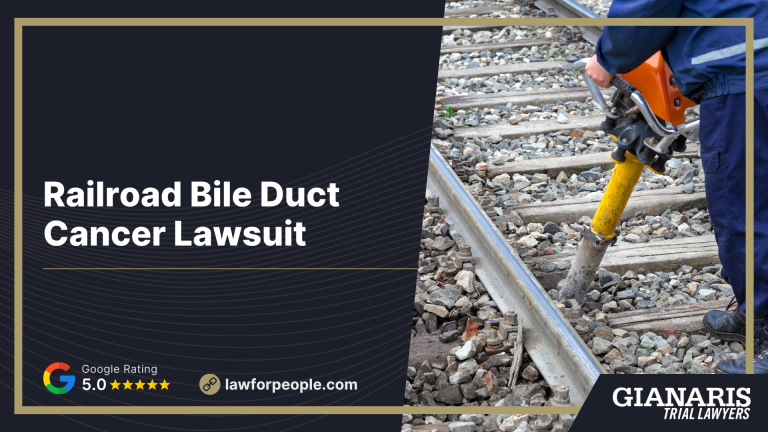Railroad bile duct cancer claims generally focus on long-term occupational exposure to toxic substances common across the railroad industry, including diesel exhaust, solvent vapors, degreasers, creosote from railroad ties, asbestos exposure, and welding fumes.
Over years of prolonged exposure, these agents can reach the hepatobiliary system, where they may contribute to inflammation, scarring, and cellular injury preceding a cancer diagnosis.
Many railroad workers (from shop crews to yard and road personnel) report regular diesel exhaust exposure in confined spaces, intermittent contact with oil-based cleaners, and residual fibers or dust in older equipment.
While each case hinges on its facts and medical history, patterns seen in railroad cancer lawsuits mirror other industrial settings in which mixed exposures have been scrutinized alongside risks for lung cancer and other malignancies.
If you or a loved one developed cholangiocarcinoma after years of railroad work, an experienced railroad cancer lawyer can evaluate whether a Federal Employers Liability Act (FELA) claim is appropriate and how best to document exposures, medical pathways, and losses.
Scientific Research Supporting Bile Duct Cancer Claims in Railroad Workers
The strongest science for toxic exposure induced bile-duct cancer (cholangiocarcinoma) points to mixed, long-term exposures common in legacy rail settings: diesel engine exhaust (PAHs/nitro-PAHs), creosote/PAHs from railroad ties, chlorinated solvents used for parts-washing (notably trichloroethylene (TCE), perchloroethylene (PCE), methylene chloride (DCM), and 1,2-dichloropropane (1,2-DCP)), and welding/metal fumes.
These toxins are often encountered in enclosed shops, roundhouses, and locomotive cabs.
While diesel exhaust is definitively linked to lung cancer, the hepatobiliary evidence is limited/suggestive, so these cases may combine mechanistic plausibility with task-based exposure reconstruction rather than one single agent.
Studies and literature on cholangiocarcinoma and occupational exposures include:
- IARC Monographs – 1,2-Dichloropropane (Vol. 110, 2017): Classified Group 1 (carcinogenic to humans)based largely on an occupational cholangiocarcinoma cluster in solvent-exposed print workers; establishes a compelling liver/bile-duct signal for chlorinated solvents relevant to rail degreasing operations.
- IARC Monographs – Methylene Chloride (DCM; Vol. 110, 2017): Group 2A (probably carcinogenic) with hepatobiliary tumor evidence in animals and oxidative/biotransformation mechanisms; pertinent where parts-cleaning utilized DCM-based products.
- IARC Monographs – Trichloroethylene (TCE; Vol. 106): Group 1 (kidney cancer in humans) with consistent liver tumors in animals and metabolites (TCA/DCA) that drive bile-duct and hepatocellular injury, probative for rail shop solvent histories.
- IARC Monographs – Perchloroethylene (PCE): Group 2A with animal liver tumors; supports mixed-solvent exposure theories where degreasers and vapor/immersion cleaners were used.
- IARC Monographs – Diesel Engine Exhaust (Vol. 105, 2012): Group 1 for lung cancer; although bile-duct evidence is limited, documentation of high historical inhalation burdens (PAHs, nitro-PAHs) in enclosed rail environments supports biologic plausibility for hepatobiliary injury.
- IARC Monographs – Polycyclic Aromatic Hydrocarbons (e.g., benzo[a]pyrene; Vols. 92/100F): Several PAHs are Group 1/2A, showing liver/biliary tumors in animals and DNA-adduct formation; directly relevant to creosote-treated ties and diesel-soot deposition.
- Welding Fumes (IARC Group 1, 2017): Established carcinogen with systemic oxidative stress and inflammatory effects; supports a pro-carcinogenic biliary microenvironment when combined with diesel/solvent aerosols in shops and engine bays.
- Occupational clusters/cohorts (printing, metalworking, transportation): Multiple case-series and case-control studies report elevated cholangiocarcinoma/hepatobiliary signals under sustained solvent/exhaust exposure, underscoring duration- and intensity-dependent risks applicable to rail tasks.
- OSHA/NIOSH standards (HazCom; TCE/PCE/DCM rules; welding; diesel): Mandate monitoring, engineering controls, and medical surveillance—probative on foreseeability and duty to protect in FELA negligence analyses.
Railroad Jobs at Risk for Exposure to Dangerous Substances Linked to Bile Duct Cancer
Jobs with the closest, routine contact to fuels, exhaust, and cleaners tend to be scrutinized in railroad cancer lawsuits.
Jobs at risk include:
- Diesel mechanics, shop workers, and sheet metal workers who repaired engines and components where diesel exhaust and solvent aerosols accumulated indoors.
- Locomotive engineers and conductors operating in or near idling power with limited air exchange and recurrent diesel exhaust exposure.
- Track and bridge crews handling railroad ties treated with creosote and working around contaminated soils, cutting oils, and degreasers.
- Electricians, pipefitters, and welders encountering welding fumes, cutting smoke, and legacy asbestos exposureduring retrofits or tear-downs.
These roles often overlap with other health issues (e.g., obstructive pulmonary disease (COPD) or chronic obstructive pulmonary disease) that can compound damages in a claim.
An experienced railroad cancer attorney can align job histories, air sampling, MSDS/SDS records, and witness testimony to show how workplace exposure plausibly contributed to disease and related losses such as medical expenses and lost wages.
Can I File a Wrongful Death Lawsuit if My Loved One Passed Away of Bile Duct Cancer?
Potentially, yes.
Under the Federal Employers Liability Act, surviving family members may pursue a wrongful-death action if employer negligence contributed to the exposures linked to a loved one’s cholangiocarcinoma.
These cases typically combine medical documentation (diagnosis, treatment chronology), an exposure narrative tied to railroad duties, and expert analysis to explain how the mix of toxic substances encountered at work could relate to the illness.
Recoverable damages in railroad cancer wrongful-death claims can include medical expenses, funeral costs, lost wages and benefits, and other pecuniary losses—sometimes resolved through a railroad cancer settlement (individual outcomes vary, and published railroad cancer settlement amounts are fact-specific).
Because timing, proof, and forum matter, consult railroad cancer lawyers promptly to review eligibility, preserve evidence, and understand how similar cancer lawsuits have been handled for railroad workers and their families.



